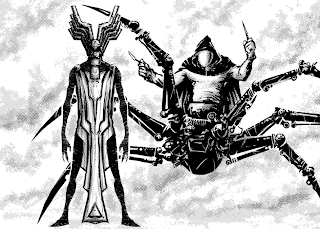Green Arrow (vol. 2) #27-28 (Dec 1989-Jan 1990)
Written by Mike Grell; Pencils by Dan Jurgens, Inks by Dick Giordano and Frank McLaughlin
Synopsis: A stranger keeps getting hassled on the streets of Seattle by thugs and criminals who mistake him for the new “Robin Hood” vigilante. Some of them begin to suspect he’s a different guy, as he deals with his opponents in a more ruthless way than the vigilante in green has previously.
The stranger (Morgan) is getting irritated at all this attention and tracks down the guy responsible: Oliver Queen, the Green Arrow. Morgan tells Queen that he's pissed a lot of people off and offers some advice:
After getting knocked down by Dinah Lance (the Black Canary) for suggesting she should “stay in the kitchen.” Morgan makes his apologies and explains who he is—leaving out any specific mention of Skartaris. As he talks over the way the world has changed with Ollie and Dinah, the crime boss whose car he shot earlier gathers a squad of goons to assault Dinah’s home and take out both his adversaries.
They cut the power before beginning the raid, but Morgan’s keen hearing still gives our heroes a bit of warning. Oliver arms himself with his bow, Morgan with his pistol, and Dinah with an uzi she takes off one of the assailants, and they defend the house against the siege.
There are just too many, though. Dinah and Ollie run out of ammunition and Morgan disappeared after an explosion. They believe him to be dead. Suddenly, he appears, clothes tattered but sword in hand, and lays into the rest of the mobsters. The boss tries to make a break for it, but:
By the time the police arrive, Morgan is gone. All Ollie and Dinah can do is tell them what happen. They do reveal that Morgan gave an address of a sort:
Things to Notice:
The similarity in appearance of Olliver Queen and Travis Morgan plays an important part in this story and may even have been the inspiration for the crossover. Queen's Van Dyke was courtesy of Neal Adams and debuted in Brave and the Bold #85 (1969). Morgan was drawn with the facial hair Grell had at the time.
This is the second time Grell has used the Disney movie Peter Pan quote "second star to the right, straight on till morning" (the word "star" is omitted in Barrie's original) to loosely refer to Skartaris. The first time was in Warlord #6 (1977), which described the first time Morgan revisited the Earth.
- Morgan apparently tried to get Veteran's benefits during this visit to the Earth.
- The story seems to imply Morgan hasn't been to the surface world in some time, but that really isn't true given the post-Grell Warlord. His last visit would have been in roughly 1986 (depicted in Annual #5).
The similarity in appearance of Olliver Queen and Travis Morgan plays an important part in this story and may even have been the inspiration for the crossover. Queen's Van Dyke was courtesy of Neal Adams and debuted in Brave and the Bold #85 (1969). Morgan was drawn with the facial hair Grell had at the time.
This is the second time Grell has used the Disney movie Peter Pan quote "second star to the right, straight on till morning" (the word "star" is omitted in Barrie's original) to loosely refer to Skartaris. The first time was in Warlord #6 (1977), which described the first time Morgan revisited the Earth.
















-1.jpg)



_0001.png)






































